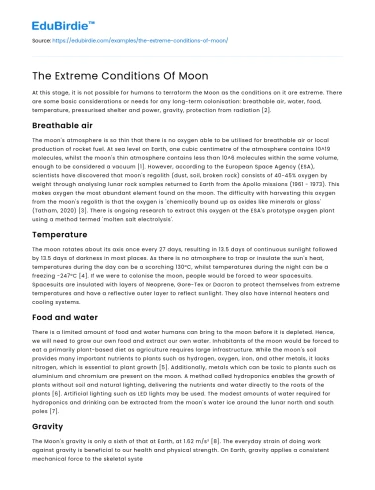At this stage, it is not possible for humans to terraform the Moon as the conditions on it are extreme. There are some basic considerations or needs for any long-term colonisation: breathable air, water, food, temperature, pressurised shelter and power, gravity, protection from radiation [2].
Breathable air
The moon's atmosphere is so thin that there is no oxygen able to be utilised for breathable air or local production of rocket fuel. At sea level on Earth, one cubic centimetre of the atmosphere contains 10^19 molecules, whilst the moon's thin atmosphere contains less than 10^6 molecules within the same volume, enough to be considered a vacuum [1]. However, according to the European Space Agency (ESA), scientists have discovered that moon's regolith (dust, soil, broken rock) consists of 40-45% oxygen by weight through analysing lunar rock samples returned to Earth from the Apollo missions (1961 - 1973). This makes oxygen the most abundant element found on the moon. The difficulty with harvesting this oxygen from the moon's regolith is that the oxygen is 'chemically bound up as oxides like minerals or glass' (Tatham, 2020) [3]. There is ongoing research to extract this oxygen at the ESA's prototype oxygen plant using a method termed 'molten salt electrolysis'.
Save your time!
We can take care of your essay
- Proper editing and formatting
- Free revision, title page, and bibliography
- Flexible prices and money-back guarantee
Temperature
The moon rotates about its axis once every 27 days, resulting in 13.5 days of continuous sunlight followed by 13.5 days of darkness in most places. As there is no atmosphere to trap or insulate the sun's heat, temperatures during the day can be a scorching 130°C, whilst temperatures during the night can be a freezing -247°C [4]. If we were to colonise the moon, people would be forced to wear spacesuits. Spacesuits are insulated with layers of Neoprene, Gore-Tex or Dacron to protect themselves from extreme temperatures and have a reflective outer layer to reflect sunlight. They also have internal heaters and cooling systems.
Food and water
There is a limited amount of food and water humans can bring to the moon before it is depleted. Hence, we will need to grow our own food and extract our own water. Inhabitants of the moon would be forced to eat a primarily plant-based diet as agriculture requires large infrastructure. While the moon's soil provides many important nutrients to plants such as hydrogen, oxygen, iron, and other metals, it lacks nitrogen, which is essential to plant growth [5]. Additionally, metals which can be toxic to plants such as aluminium and chromium are present on the moon. A method called hydroponics enables the growth of plants without soil and natural lighting, delivering the nutrients and water directly to the roots of the plants [6]. Artificial lighting such as LED lights may be used. The modest amounts of water required for hydroponics and drinking can be extracted from the moon's water ice around the lunar north and south poles [7].
Gravity
The Moon's gravity is only a sixth of that at Earth, at 1.62 m/s² [8]. The everyday strain of doing work against gravity is beneficial to our health and physical strength. On Earth, gravity applies a consistent mechanical force to the skeletal system, which maintains the density and healthiness of bones. Under the effect of low gravity, calcium in bones secretes out through urine and bone loss occurs. As the bones weaken, astronauts are more susceptible to osteoporosis and bone fractures. Additionally, without regular use and exercise of our muscles, they weaken and deteriorate through a process termed 'atrophy'. According to Kevin Fong, a senior lecturer in physiology at University College London, experiments performed in outer space showed that rats lost more than 1/3 of their quadricep's total bulk muscle within 9 days. Such a low gravitational acceleration would require lunar inhabitants to exercise for hours on a daily basis in order to maintain bone and muscle mass [9].
Radiation
On Earth, we are protected from most of the sun's ionising radiation. The Earth’s strong magnetic field lines allow for a magnetosphere, a region of space that diverts most solar/cosmic radiation, while the Earth’s thick atmosphere absorbs the rest. The lack of a substantial atmosphere and magnetic shielding on the moon allows solar flares and cosmic radiation to penetrate the lunar surface and into human bodies, in addition to meteorites [10]. According to NASA, 'all this radiation penetrating human flesh can damage DNA, boosting the risk of cancer and other maladies' [11]. Protective spacesuits will have to be worn, and astronauts can build shelter underground [11].
Shelter
Lunar lava tubes on the moon could serve as a shelter from the Moon's severe environment. The surface of the moon is frequently bombarded by meteorites, solar flares, cosmic radiation and extreme hot and cold temperature variations [12]. The temperature of underground lava tubes would be around -23°C, providing liveable conditions with heaters and thick insulating clothes [13]. Another possible lunar outpost could be located at the north or south poles. There is conclusive evidence for the presence of water ice in areas near the poles, which we can extract for drinking water and growing plants[14]. Additionally, the poles are mostly exposed to the Sun, providing nearly continuous power from solar panels if installed, only being unavailable during a lunar eclipse [15].
References
- https://www.nasa.gov/mission_pages/LADEE/news/lunar-atmosphere.html
- https://www.youtube.com/watch?v=I5V2tcg1BvQ
- https://science.howstuffworks.com/what-if-moon-colony.htm
- https://www.wtsp.com/article/tech/science/space/esa-scientists-make-oxygen-from-moon-dust/67-2d30436f-a084-4141-a44f-23527d7d7bcb
- https://nineplanets.org/questions/what-is-the-temperature-on-the-moon/
- https://theprint.in/science/building-thick-houses-eating-tomatoes-the-unexpected-realities-of-living-on-the-moon/274580/
- https://theconversation.com/how-urban-farmers-are-learning-to-grow-food-without-soil-or-natural-light-88720
- https://www.space.com/41554-water-ice-moon-surface-confirmed.html
- https://www.enotes.com/homework-help/acceleration-due-gravity-moon-1-62-m-s2-349724
- https://www.wired.com/2014/02/happens-body-mars/
- https://www.nasa.gov/feature/goddard/2019/how-nasa-protects-astronauts-from-space-radiation-at-moon-mars-solar-cosmic-rays
- https://science.nasa.gov/science-news/science-at-nasa/2005/08sep_radioactivemoon
- https://www.space.com/moon-colonists-lunar-lava-tubes.html
- https://www.youtube.com/watch?time_continue=98&v=EjOgdBm1dqc&feature=emb_logo
- https://www.popsci.com/for-nearly-infinite-power-build-self-replicating-solar-panels-on-moon/






 Stuck on your essay?
Stuck on your essay?

